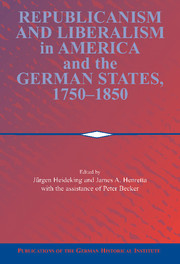Book contents
- Frontmatter
- Introduction
- PART I OVERVIEW
- PART II THE REPUBLICAN WORLD
- 2 The Concept of the Republic in Eighteenth-Century German Thought
- 3 Kant’s Republicanism and Its Echoes
- 4 Constitutions, Charity, and Liberalism by Default: Germany and the Anglo-American Tradition
- 5 Politics and Sentiment: Catharine Macaulay’s Republicanism
- 6 Between Liberalism and Republicanism: “Manners” in the Political Thought of Mercy Otis Warren
- PART III THE TRANSITION FROM REPUBLICANISM TO LIBERALISM
- PART IV THE LOGIC OF LIBERALISM
- Index
6 - Between Liberalism and Republicanism: “Manners” in the Political Thought of Mercy Otis Warren
Published online by Cambridge University Press: 05 January 2013
- Frontmatter
- Introduction
- PART I OVERVIEW
- PART II THE REPUBLICAN WORLD
- 2 The Concept of the Republic in Eighteenth-Century German Thought
- 3 Kant’s Republicanism and Its Echoes
- 4 Constitutions, Charity, and Liberalism by Default: Germany and the Anglo-American Tradition
- 5 Politics and Sentiment: Catharine Macaulay’s Republicanism
- 6 Between Liberalism and Republicanism: “Manners” in the Political Thought of Mercy Otis Warren
- PART III THE TRANSITION FROM REPUBLICANISM TO LIBERALISM
- PART IV THE LOGIC OF LIBERALISM
- Index
Summary
Historians have recently declared a truce in the debate concerning the relative influence of liberalism and republicanism during the revolutionary era of American history. James T. Kloppenberg, Isaac Kramnick, John Murrin, and Daniel T. Rodgers, among others, have concluded that neither liberalism nor republicanism dominated early American political thought. Both are, in fact, more productively seen as fluid discourses rather than as fixed ideologies. As Forrest McDonald puts it, eighteenth-century Americans were “politically multilingual, able to speak in the diverse idioms of Locke, the classical republicans, Hume, and many others.” These divergent discourses ebbed and flowed over time and were strategically employed to meet the needs of various situations and events.
The new synthesis tends to assume that the discourses coexisted as complementary ideals. However, liberalism and republicanism (particularly classical republicanism) offer two different and at times contradictory visions of the individual, society, and the public good. Self-interest, for example, can conflict with one's ability to sacrifice for the common good. An assertion of individual rights and liberties can undermine an organic sense of community. A belief in social equality challenges the presumption of hierarchy. How did people in early America reconcile these contradictions?
One American thinker who grappled with this tension was Mercy Otis Warren. In numerous plays, poems, satires, and in her magisterial three volume History of the Rise, Progress, and Termination of the American Revolution, Warren articulated a vision of society that was simultaneously liberal and classically republican. She expressed both a staunch dedication to the ideal of civic virtue and an unwavering commitment to civil liberties, a belief in the common good along with support for the pursuit of individual self-interest. Linking these two discourses was the concept of “manners.” Like other eighteenth-century political thinkers Warren understood manners to mean something more than proper rules of etiquette or correct modes of social deportment. For her, manners referred to an internalized set of beliefs that regulate social behavior – the norms that produce sociability, benevolence, and civic virtue. If Americans practiced appropriate manners, according to Warren, then they could pursue their own interests as well as serve the common good. Manners thus eased the tensions between the individualistic thrust of liberalism and the communal impulse of classical republicanism.
- Type
- Chapter
- Information
- Publisher: Cambridge University PressPrint publication year: 2002

